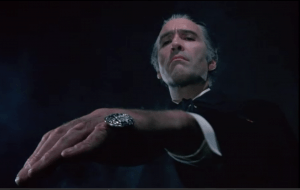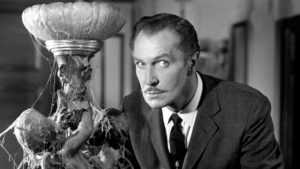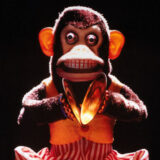
Twitter has contained plenty of reminders in recent days that we have just passed the birthdays of three horror legends: Peter Cushing, born May 26th 1913; Vincent Price, born May 27th 1911; and Christopher Lee, born May 27th 1922.
Those three stars shaped horror cinema in the 20th century as much as any director or screenwriter. They were hugely important to the genre – and it looks pretty certain that we shall not see their like again.

They were not, of course, the first bankable genre stars. But whereas Boris Karloff and Bela Lugosi dominated the genre’s original golden era, these three actors ruled for the next several decades – and each of them had unique qualities which had a profound influence.
Without Peter Cushing, the boom in British horror cinema might never have happened, and therefore we might not have seen the revival in American Gothic cinema that followed. Cushing was already well-known on British television by the time he was hired to make The Curse of Frankenstein (1957), and with that film he immediately established himself as a new star of the genre. His subsequent career included playing Frankenstein five more times, Van Helsing five times (three times opposite Christopher Lee, twice without) and Sherlock Holmes once on film as well as on TV.
He had range, but there is one characteristic that Cushing’s performances are surely remembered for more than anything: a steely single-mindedness. His Van Helsing and his Frankenstein are opposite sides of the same coin. Both have unshakable belief in what they do – but one is devoted to eradicating evil, the other to pursuing his deluded ambitions. If he had been encouraged to take the same approach to the character of the Doctor in his two Doctor Who movies, instead of acting the kindly old gent, he might have added another classic performance to his credits.
(Oddly enough, the other quality Cushing portrayed frequently was a near-hysterical nervousness, often in characters whose rigid control of their lives had been undermined. These roles can seem uncomfortably like watching the ‘real’ Cushing, given what he himself revealed about his experience of mental breakdown, under-confidence and his heavy dependence on his wife’s emotional support.)

Christopher Lee had been hired to play the monster in The Curse of Frankenstein on the basis of his height as much as anything else, but he was engaged again for Dracula (retitled Horror of Dracula in the US) and instantly became a star. For decades afterwards, he would have a love-hate relationship with Dracula and horror. But that career-making performance displayed the qualities that would serve Lee and the genre so well: an aristocratic arrogance, reinforced by his huge physical presence and given a veneer of urbane charm. When he played the hero in one of British horror’s greatest movies, The Devil Rides Out (1968; US title: The Devil’s Bride), he was scarcely less lofty and remote than he was as a vampire.
These two actors established, for decades to come, the way horror would normally be played. The key was conviction; somehow they managed to be deadly serious without striking the false notes that marred the performances in so many lesser Hollywood genre films.
Chronologically, Vincent Price should come first among this trio. He was the eldest of them and the first to make a genre film – and had amassed a substantial list of movie credits before he did so. But I’ve left him until last because he is the most complicated
Price had somehow been diverted from playing respectable supporting roles to starring in 1950s Hollywood horrors like House of Wax, The Fly and Return of the Fly. Then came the unashamedly gimmicky William Castle movies House on Haunted Hill and The Tingler before Roger Corman’s decidedly arty cycle of Edgar Allan Poe adaptations in the 1960s.
Whereas Cushing and Lee generally played men of total resolve, for good or evil, the abiding memory of Price is in much less assertive roles. He is tortured, cursed, forever complaining about his lot. Maybe it’s Poe, or maybe it’s Price, but he is often a fragile character whose instinct is to run away from horror rather than confront it.

When he wasn’t acting anguished, Price would sometimes play for laughs, as in Corman’s The Comedy of Terrors (1963). This was something that we almost never saw Cushing and Lee do in the genre, although they had the talent for it. And in the early 1970s, Price came to Britain for a trio of outlandish horror movies with a lot of humour: The Abominable Dr Phibes¸ Dr Phibes Rises Again and Theatre of Blood. The campy tone of these moves was not a million miles from the Batman TV series in which Price had played Egghead.
Knowing what we do about the off-screen Price – his waspish humour, his taste for the fine arts, his posthumously-revealed bisexuality – it’s all the more tempting to see him as a subversive figure in the genre, spreading ambiguity where Cushing and Lee portrayed certainty and polarity. Of course, Price could be deadly serious, as in Witchfinder General (1968; aka The Conqueror Worm), but I’m inclined to think that didn’t come naturally.
All three actors lived to see their work honoured by younger generations. Price appeared in Tim Burton’s Edward Scissorhands. Cushing, of course, was in Star Wars. And Lee, who felt so ambiguous about his Dracula movies, was eventually sought out by directors like Joe Dante and Peter Jackson who had grown up loving those films. In time, of course, he followed in Cushing’s footsteps by taking a role in the Star Wars series.
Today, the horror genre doesn’t really have a star of its own creation whose name would guarantee big theatrical box office receipts. But our very conception of horror movies – whether they are delivered with conviction or with knowing, transgressive humour – still owes a great deal to the legacy of Cushing, Lee and Price.











Price was “diverted” by the Red Scare. He was graylisted by the HUAC and gladly took any role he could get after that.
When actors were really actors and not ridiculous politicians……………………Great movies, too bad they don’t make them like this anymore!!!!!